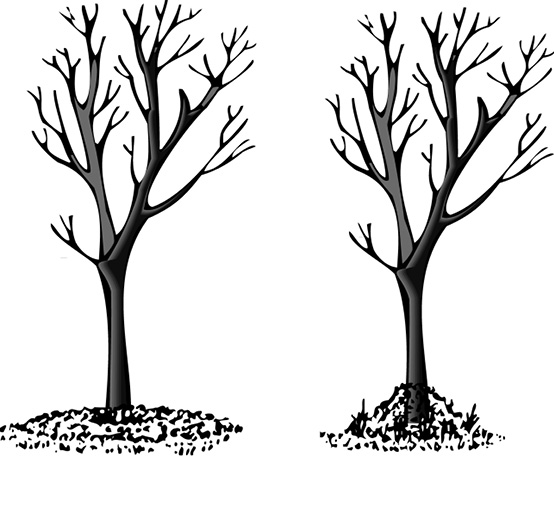Mulches for the Landscape
Mulch helps keep your garden and landscape healthy. Mulching occurs regularly in nature with fallen leaves, twigs, spent flowers, and other materials. These natural mulches have provided a protective covering for the soil. They, along with inorganic mulches, can do the same in your garden.
Benefits of Mulching
- Help the soil hold moisture by reducing evaporation.
- Control weeds in a garden. To prevent weeds, mulches should be weed-free and must be applied deep enough to prevent weed seed germination as well as smother existing weeds.
- Regulate soil temperature. They keep the soil cooler during hot days and warmer during cold days.
- Prevent soil crusting, thus improving water absorption and percolation. This helps reduce soil erosion.
- Improve the soil structure through decomposition and the addition of organic matter to the soil.
- Enhance soil aeration, water percolation, and retention. Organic matter also adds nutrients to the soil.
- Reduce soil splashing, which prevents soil-borne diseases from splashing onto plants.
- Protect ripening vegetables (tomatoes, melons, pumpkins, squash) from contact with the soil, reducing rotting and “bad” spots on the fruit.
- Protect the trunks of trees and shrubs from lawn equipment such as string trimmers. Lawn equipment can severely damage trees and shrubs by girdling or wounding the trunk, affecting the movement of water, minerals, and sugars through the plant.
- Beautify your garden and landscape.
Types of Mulch
Mulch can be any material that provides these benefits. To be effective, mulch should be porous enough to let water and air pass through it, as well as dense enough to prevent weed growth. Two basic types of mulches are organic and inorganic.
Organic mulches are plant material and will decompose and help build soil structure. Organic mulches must be replenished periodically.
Inorganic mulches are inert and are not composed of organic material. Inorganic mulches, (stone, plastic, or fabric) do not decompose, generally stay in place, do not contain weed seeds, and do not deplete nitrogen from the soil. However, they can be expensive and they do not contribute organic matter to improve soil structure. Unless used with landscape fabric, inorganic mulches may migrate down into the soil.
See Table 1 for more information on the different types of mulch and the benefits and drawbacks of each.
How to Mulch
New plantings—Mulching around new plantings helps keep moisture in the root ball of the new plant until the roots have established in the surrounding soil.
Annual and perennial flower beds and vegetable gardens—Mid-spring is the ideal time to mulch annual and perennial flower beds and vegetable gardens after the soil has warmed for active root growth. Remove existing weeds before applying the mulch. Apply winter mulches after the soil has cooled but before it has frozen. Mulch the entire bed. For more information on mulching a vegetable garden, see Extension Publication 3616 Mississippi Vegetable Gardener's Guide.
Trees and shrubs—For trees and shrubs in a bed, mulch the entire bed. For those in a lawn, mulch a 3- to 6-foot-wide ring from the trunk out. It should be about 4–6 inches deep. Keeping trees and shrubs mulched will prevent lawn equipment damage. DO NOT place mulch directly against the trunk of the trees and shrubs. Pull the mulch back from the trunk about 2 to 3 inches. This will prevent problems caused by wet mulch and rodent damage. See Figure 1.

Mulching Tips
- Weed an area before applying mulch. This is also a good time to apply a preemergence herbicide.
- Maintain mulched areas and keep mulch uniform in depth. This will prevent weed problems.
- Heavy mulching (with organic mulches) over several years may result in a buildup of soil around the base of plants. This can damage plants and may result in insect and disease damage. After 3 years, rake off old mulch and apply a new layer. This buildup may also affect the soil chemistry, so be sure to have the soil tested.
- If the mulch pile starts to smell like vinegar, ammonia, sulfur, or silage, your mulch has gone sour. Soured mulch can damage plants and be unpleasant. To prevent mulch from souring or to cure soured mulch, turn the mulch pile once or twice a month, or more frequently if the pile is wet. Good aeration should eliminate toxic chemicals within 24 hours.
How Much Mulch Do You Need?
Before purchasing mulch, you need to calculate the area and depth of coverage to determine how many cubic feet of mulch you should buy. Bulk quantities of mulch are sold in cubic yard volumes.
First, determine the square foot measurement of the areas to be mulched. For example, if you have a perennial/shrub border 5 feet wide and 20 feet long, the area to be mulched equals 100 square feet.
Now, if you are going to apply mulch 4 inches deep to this area, convert the 4 inches to a fraction of a foot: 4 inches / 12 inches = 1/3 foot or .33 feet.
Multiply this fraction by the square foot measurement of the area to be covered: .33 feet x 100 square feet = 33 cubic feet.
One cubic yard equals 27 cubic feet. In the example above, you need 1 cubic yard of mulch plus an extra 5 cubic feet of mulch: 27 cubic feet (1 cubic yard) + 5 cubic feet = 33 cubic feet.
Before you purchase mulch in bulk (by the cubic yard), compare the cost with purchasing your mulch in smaller units.
Bagged mulch is also available in amounts such as 1.25 cubic feet or 2.0 cubic feet. If you purchase the mulch needed for the example given above in 1.25 cubic feet bags, you will need 27 bags (33 cubic feet divided by 1.25 cubic feet = 26.4 bags). If you purchase bags of 2.0 cubic feet, you will need 17 bags (25 cubic feet divided 2 cubic feet = 16.5 bags).
|
Mulches |
Advantages |
Disadvantages |
Application Rate |
|---|---|---|---|
|
Pine or hardwood bark |
Slow to decompose, resists compaction, does not blow away, very attractive, readily available |
Large nuggets tend to float away in heavy rain; not recommended next to foundations as may attract termites |
2 to 3 inches |
|
Cypress bark |
Tends not to float, long lasting, some insect resilience, should only be from sustainable sources |
Sometimes hard to find from sustainable sources, expensive, difficult to wet once dry |
2 to 3 inches |
|
Cocoa-bean hulls |
Long lasting |
Compact, expensive |
3 to 4 inches |
|
Compost |
Organic matter, contains minerals, microorganisms, improves structure and drainage |
None |
2 to 3 inches |
|
Geotextiles (landscape fabrics, groundcloths*) |
Reduces weeds, allows air and water to penetrate, easy to apply |
Not attractive, needs to be tied down or covered with another type mulch |
1 layer |
|
Grass clippings |
Readily available, nutrient recycling |
May mat, herbicide residues may harm plants, better left on the lawn, may contain weed seeds |
1 to 2 inches |
|
Gravel, pebbles, stones* |
Inexpensive, wide selection, permanent |
Use weed fabric underneath to prevent weeds, gets hot and has reflective heat, don’t use around acid-loving plants as leeching may increase the alkalinity of the soil |
1-inch layer |
|
Leaves |
Readily available, nutrient recycling, shredded leaves best |
Decompose rapidly, whole leaf may mat when wet or blow away when dry |
Whole – 6 inches Shredded – 2 to 3 inches |
|
Newspapers |
Readily available, good for weed control, good for vegetable gardens |
Not attractive, needs another mulch to hold down and make more attractive |
3 to 6 sheet layers |
|
Pecan, nut shells |
Effective in retaining soil moisture, durable |
Limited availability |
1 to 2 inches |
|
Plastics* |
Retains soil moisture, controls weeds |
Not attractive, needs another mulch to hold down, not recommended in areas with poor drainage, must cut holes to allow water into the soil |
1 layer |
|
Pine needles |
Attractive, decomposes slowly, readily available, stays in place |
Will lower soil pH, can be a fire hazard |
6 to 8 inches |
|
Recycled rubber tires* |
Long lasting, does not blow away |
Heat can build up, not biodegradable, expensive |
2 to 4 inches |
|
Sawdust |
Acidifying effect on soils |
Poor weed prevention, packs down making it hard to wet, depletes nitrogen |
2 to 3 inches |
|
Wheat straw |
Inexpensive, insulating, good for vegetable gardens |
Decomposes rapidly, can deplete nitrogen, unattractive |
6 to 8 inches |
|
Wood chips, or shredded wood |
Slow to decompose, readily available, resists compaction, remains in place, weathers well |
Can deplete nitrogen, should not be used next to foundations as may attract termites |
2 to 4 inches |
*Inorganic mulch
References
Campbell, S. 1993. “The Mulch Book.” Pownal, VT: Storey Publishing.
Kluepfel, M., and B. Polomski. 1999. “Mulch.” HGIC 1604. The Clemson University Cooperative Extension Service.
Relf, D. 2001. “Mulching for a Healthy Landscape.” Publication 426-724. Virginia Cooperative Extension.
Klett, J. E. 2007. “Mulches for Home Grounds.” Publication no.7.214. Colorado State University Cooperative Extension.
Publication 2301 (POD-10-23)
Reviewed by Jeff Wilson, PhD, Assistant Horticulture Professor, North Mississippi Research and Extension Center. Revised by Gary Bachman, PhD, Extension Professor Emeritus, from an earlier edition by Sonja M. Skelly, PhD, former Consumer Horticulture Specialist.
The Mississippi State University Extension Service is working to ensure all web content is accessible to all users. If you need assistance accessing any of our content, please email the webteam or call 662-325-2262.







